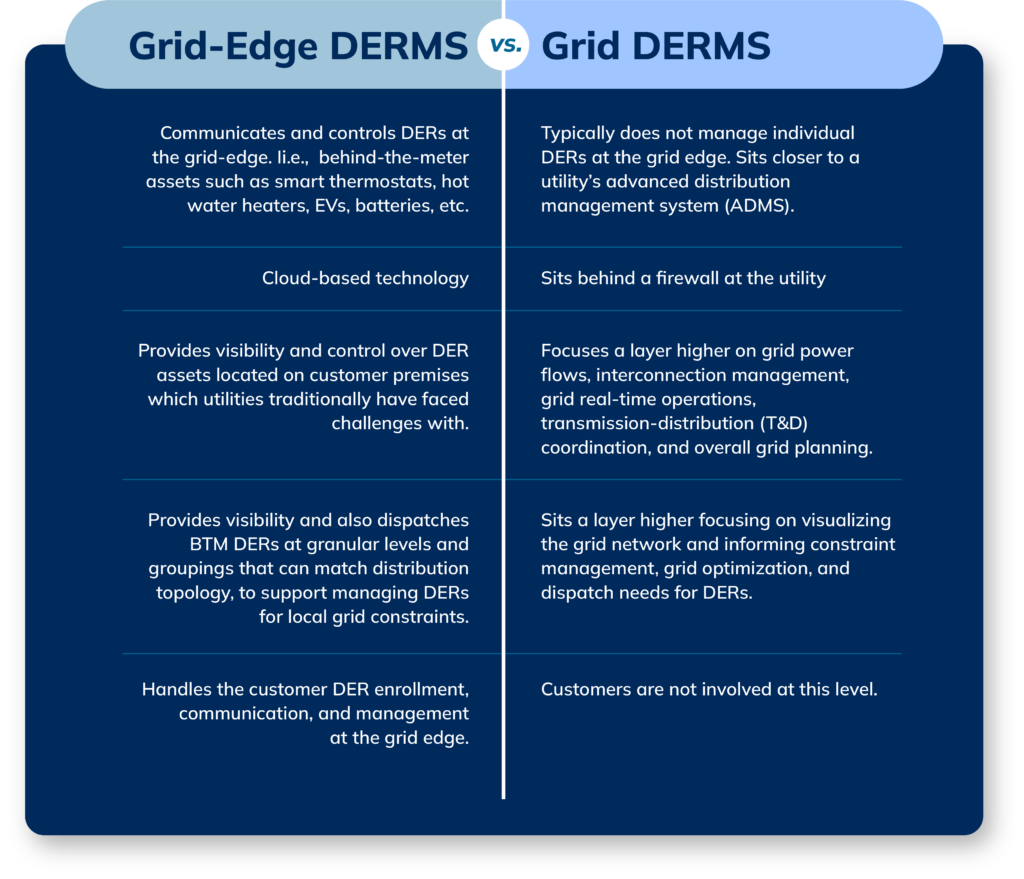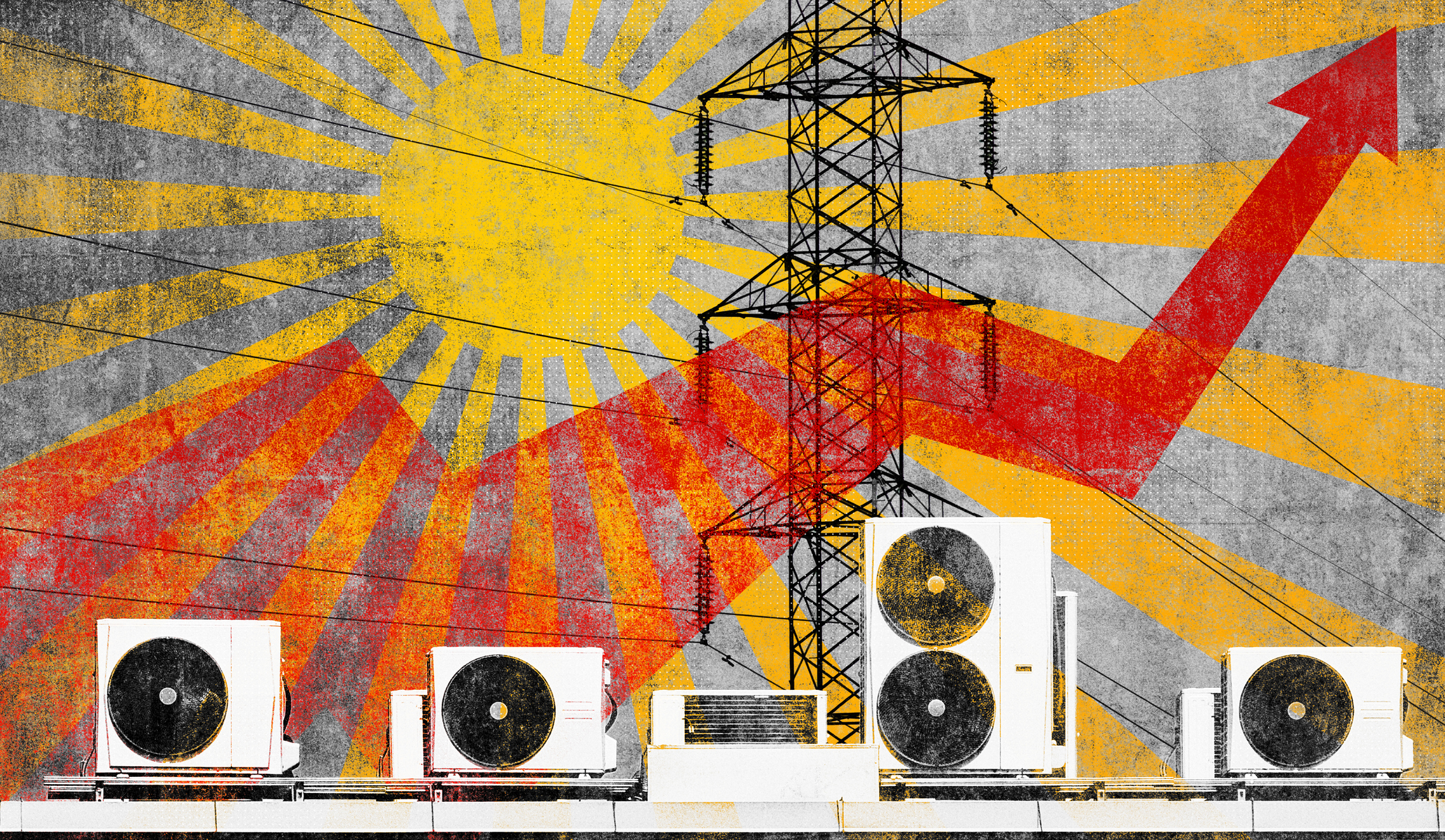The distributed energy resource (DER) market is expected to double by 2027, demonstrating a simultaneous increase in device adoptions and consumer confidence. This uptick in adoption rates presents a tangible opportunity for utilities to balance electrification initiatives and the increasing frequency of extreme weather and temperature events with meeting customer demand. These DER assets are manageable through a distributed energy resource management system (DERMS), which aggregates these resources for use in demand flexibility initiatives like demand response, EV managed charging, or virtual power plants. Depending on the objective, utilities may aggregate DERs through a Grid DERMS or a Grid-Edge DERMS for their load management strategies. So what’s the difference between the two?
What is a DERMS?
Traditionally, utilities have employed advanced distribution management systems (ADMS), which provide network monitoring, outage management, grid maintenance information, and some automated switching. By contrast, distributed energy resource management systems (DERMS) are designed to handle otherwise disparate DER resources for use in load flexibility initiatives or to help with energy costs through the wholesale electricity market. These two systems often work together, creating a reciprocal ecosystem of connected devices, analytical and system information, and opportunities to meet strategic energy arbitrage goals.
Altogether, a distributed energy resource management system (DERMS) is, as advertised, a platform used to aggregate DER technologies. The Guidehouse Insights Leaderboard: DERMS Providers report, an assessment of DERMS by type, defines DERMS as a “software platform capable of intelligently managing, controlling, and optimizing DER aggregations to provide grid services and differentiates between grid DERMS platforms and grid-edge DERMS platforms.”
This distinction demonstrates not just a difference in design, but functionality: not all DERMS are created the same. Some are considered more or less reliable and have different roles within the overall utility ecosystem. Before we break down the specifics, let’s examine the reliability challenges present in DER management.
DER Intermittency
So far, distributed energy resources (DERs) have proven too intermittent for utility operators to comfortably depend upon; unlike fossil fuels which are available and proven on demand, the renewable energy provided by DERs requires specific conditions to generate. The Pathways to Commercial Liftoff: Virtual Power Plants report from the Department of Energy states that to continue to meet demand, virtual power plant capacity must increase to between 80-160 GW by 2030 to keep pace with electrification efforts. As it stands, the DOE report states that the current available VPP capacity in the U.S. is between 30-60 GW, most of which is derived from demand response programs.
Because of the intermittency of DERs, specifically the behind-the-meter DER assets often found in residential homes, grid operators rarely rely on these assets to meet demand; it’s understandable considering they cannot guarantee the required outcome needed to meet electric demand. Fortunately, Topline Demand Control was created to address this understandable concern. A capability of a Grid-Edge DERMS that leverages forecasting technologies, artificial intelligence, and Model Predictive Control to optimize DERs, providing the precise aggregate load a utility requests throughout a demand event window.
What are Grid-Edge DERMS & Grid DERMS
Currently, the primary distinction between DERMS addresses these exact disparities in demand outcome. While distributed energy resource management systems (DERMS) are designed to aggregate devices, this strategy is currently distinguished between Grid DERMS and Grid-Edge DERMS, a relatively recent concept and one worth unpacking.
- Grid DERMS – controls and monitors grid-scale assets, and DER resources that are often utility-owned and maintained.
- Grid-Edge DERMS – By contrast, a Grid-Edge DERMS controls and monitors aggregate behind-the-meter DER assets like thermostats or water heaters.
These differences entail different approaches to internal vs. customer programs and feature different pros and cons between the two, although both are ultimately valuable in shifting, generating, or managing load to meet demand and/or flatten energy arbitrage curves. Below is a chart that further details the differences between the two.
Grid-Edge DERMS are further categorized by one of three development types. More specifically, utilities considering a Grid-Edge DERMS may consider one of the following criteria:
- Purpose-built DERMS – This type of DERMS is designed to the specifications of each utility. As such, they can take time to develop, further delaying deployment, while also yielding a solution that is slow to adapt.
- Vendor-Led Solutions – This solution type is created and managed by a third party, meaning a utility would cede the entirety of the customer journey to an outside party, which can lead to troubling results.
- Flexible Self-Service SaaS – This cloud-based SaaS solution is the best of both worlds, a vendor-created solution that puts the customer journey in the hands of the utility, designed with adaptability in mind.
Grid-Edge DERMS vs. Grid DERMS
As you can see below, while both Grid-Edge and Grid DERMS aggregate distributed energy resources (DER) they do so by dramatically different, if entirely reciprocal, approaches. Grid-Edge DERMS leverage the wealth of DER assets flooding the market, while also providing an opportunity as electrification efforts continue to yield even more DERs for homeowners. These technologies are cloud-based, communicate with behind-the-meter devices, and are often built to handle customer engagement/administrative functionalities like device enrollment, communication, and management at the grid edge, all while providing robust analytics and flexible dispatching opportunities.

By contrast, Grid DERMS were designed to manage utility-scale projects rather than the fleet of otherwise disparate behind-the-meter assets that Grid-Edge DERMS were built to address. These platforms work behind a firewall and are much closer to a utility ADMS, focusing on constraint management, grid optimization, and more, none of which directly impacts customers.
Conclusion: Grid-Edge DERMS & Grid DERMS
Ultimately, both Grid DERMS and Grid-Edge DERMS are necessary to increase the virtual power plant capacity needed to continue to meet needs, while meeting decarbonization goals. As more customers adopt distributed energy resources (DERs), Grid-Edge DERMS represents an opportunity to tap into a large available pool of energy assets, assets that require a minimal investment to benefit utility operators. Furthermore, while Grid DERMS has a track record for satisfying grid operator needs, Topline Demand Control has rendered Grid-Edge DERMS equally valuable as reliable energy assets that can meet electric needs on demand.






